Robins/Coasters
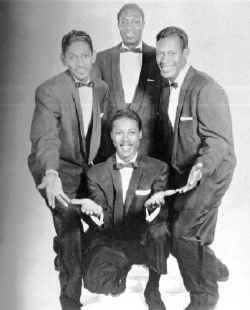
Left clockwise: Carl Gardner, Billy Nunn,
Leon Hughes, Billy Guy
The Coasters comic vocals plus the writing and production of
Jerry Leiber and Mike Stoller resulted in a string of
wisecracking hits in the late fifties. they were among the first
black singing groups to cross over and to be considered rock and
roll.
Members:
Robins
Carl Gardner - lead
Bobby Nunn - bass
Ty Terell - tenor
Grady Chapman - tenor
Billy Richards
Ray Richards |
Coasters
Carl Gardner
Bobby Nunn - replaced by Young Jessie
- replaced by Cornell Gunter- replaced by Earl
"Speedo" Campbell in 1960
Leon Hughes - second tenor - replaced
by Will "Dub" Jones (1958) - replaced by Ronnie
Bright (60s)
Billy Guy - first tenor
|
|
In Oakland, California in 1945 two brothers
William and Ray Richards, with a friend, Ty Terell formed a trio.
A year later they traveled to Los Angeles where they hoped to
make it into the music business, Their main influence was secular
music, rather then the rhythm and blues artists who had direct
religious backgrounds. Originally called the A Sharp Trio they
had trouble finding work. They soon began hanging out at the
Barrelhouse Club, a Watts hangout for aspiring young R&B
artists, owned by Johnny Otis. Otis took an interest in them and
set a date for a recording session. Bobby Nunn on bass was added
and the group became the Four Bluebirds.. The Richard brothers
sang baritone and Terell lead tenor. At the session they cut
"My Baby Done Told Me' b/w "Courtroom Blues" on
Excelsior. The groups name changed once again to the Robins.
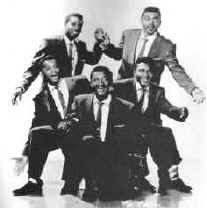
The Robins - 1953
(L-R) Top: Roy Richards, Bobby Nunn
( L-R) Bottom: Grady Chapman, Ty Terell, Billy Richards
The Robins recorded for Aladdin and it's subsidiary, Score, in
1949. By this time they were a featured attraction with the
Johnny Otis Show. In 1949 and 1950 they often backed Little
Esther or Mel Walker on sessions produced by Otis for Savoy
Records.
The group began in Los Angeles in the late forties and were
known as the Robins. In 1950 they had a number one hit with
"Double Crossing Blues" featuring Little Esther
Phillips. In 1953 they met Leiber and Stoller when they moved
from Crown Records to RCA. In 1954 Robins followed Leiber and
Stoller to Spark Records
Richard Berry was borrowed from the Flairs to sing bass lead
on the Robins first release for Spark Records "Riot In Cell
Block #9". While not a national hit it did sell 100,00
copies in Los Angeles and the Bay area.
The Robins became the label's most successful act with
"Riot In Cell Block No. 9," "Framed,"
"The Hatchet Man" and "Smokey Jo's
Cafe". In 1955 Atlantic bought the Robin's catalogue
and contracted Leiber and Stoller as independent producers for
other Atlantic acts.

Coasters 1957-1958
(clockwise from top left) Bobby Nunn, Carl
Gardner Billy Guy, Leon Hughes
At that time the group split with Carl Gardner and Bobby
Nunn staying with Leiber and Stoller and Billy Guy, a comedic
singer with unlimited vocal inflections and Leon Hughes were
added. The new group was named the Coasters. Their first single
"Down In Mexico" went top ten R&B in 1956.
The next single "One Kiss Led To Another" went
nowhere. Next "Searchin" b\w "Young
Blood" went #1 pop and #3 in 1957. The record quickly sold
two million copies as deejays first played one side then the
other. However, there were people that didn't care for their
clowning about sexual subjects.
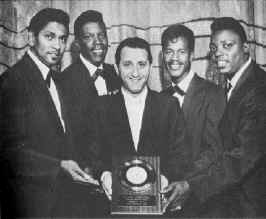
Coasters and manager Lester Sill
with gold record for Yakety Yak
The next three singles barely sold. It wasn't the
material or the delivery but, rather that they got caught in a
backlash against rock and roll. Leiber and Stoller and the group
moved to New York in 1957. Cornell Gunter, who had sung for the
Flairs, replaced Jesse Obe. Bobby Nunn quit and was
replaced by Will "Dub" Jones formerly with the
Cadet Jacks in 1958 The next record to chart was "Yakety
Yak" (#1, 1958) "Yakety Yak" was aimed at
teenagers, talking to them about problems they actually
experienced.
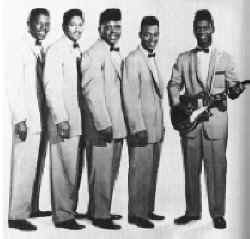
Coasters 1958-1960
L to R: Will "Dub" Jones,
Carl Gardner, Cornell Gunther, Billy Guy, Adolph Jacobs
Followed by "Charlie Brown" (#2, 1959), was written
to appeal specifically to teenagers. The Coasters and Leiber and
Stoller now had a proven formula. "Along Came
Jones" (#9, 1959) dealt with America's preoccupation with
Westerns and "Poison Ivy" (#7, 1959) preached the
lesson of "look but, don't touch". By the end of the
Fifties the Coasters were America's most popular black rock and
roll group.
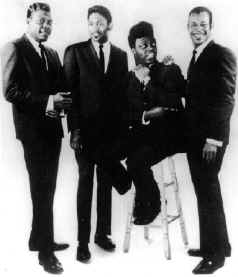
From left: Will "Dub" Jones,
Carl Gardner, Cornell Gunter, Billy Guy
The Coasters had four records make the top forty in 1960 and
1961 and continued to record for Atco until 1966. Their last
record to chart was with a Leiber and Stoller re-produced
"Love Potion #9" in 1971. "If I Had A Hammer"
was their last record released in 1976. Since then, Nunn,
Gardner, and Hughes individually, and Guy and Jones together, at
one time or another all led groups billed as the Coasters.
In 1988 Gardner, Guy, Jones, and Gunter (with Tom Palmer)
performed at Atlantic Records' 40th anniversary concert in New
York City. Gunter was murdered in Las Vegas in 1990.
The Coasters were inducted into the Rock and Roll Hall
of Fame in 1987
Robins:
Roy Richard died on May 1, 1983.
Bobby Nunn died from a heart attack on November 5, 1986.
Billy Richard died from a fall while exercising on December 10,
2007.
Grady Chapman died of congestive heart failure on January 4,
2011.
Coasters:
Bobby Nunn died from heart failure November 5, 1986
Leon Hughes died of natural causes March 1, 2023 at the age of
92.
Cornell Gunter was founded shot shot in his car in Las Vegas,
Nevada on February 26, 1990. He was 53 at the time
of his death.
Carl Gardner, Sr. died on June 12, 2011, after suffering with
congestive heart failure and vascular dementia.
Billy Guy died on November 5, 2002, in Clark County, Nevada, of
cardiovascular disease.
Will "Dub" Jones died in January 2000, from the effects
of diabetes. He was 71 years old
Earl "Speedo" Carroll died on November 25, 2012, of
complications from a stroke and diabetes.
Ronnie Bright died on November 26, 2015, at the age of 77.
Obie "Young Jessie" Jessie died on April 27, 2020, aged
83
Carl Gardner
and the Coasters
Claus' Coasters
Page - Those Hoodlum Friends of Mine






